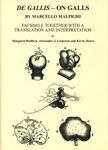![The Codex Canadensis and the Writings of Louis Nicolas The Codex Canadensis and the Writings of Louis Nicolas]()
Click to have a closer look
About this book
Biography
Related titles
About this book
Part art, part science, part anthropology, this ambitious project presents an early Canadian perspective on natural history that is as much artistic and fantastical as it is encyclopedic. Edited and introduced by François-Marc Gagnon, The Codex Canadensis and the Writings of Louis Nicolas showcases an intriguing attempt to document the life of the new world – flora, fauna, and aboriginal.
The book brings together for the first time the illustrated Codex Canadensis and The Natural History of the New World, following Gagnon's argument that both can be attributed to Louis Nicolas, a French Jesuit priest who travelled throughout Canada between 1664 and 1675. Histoire Naturelle des Indes Occidentales, originally written in classical French, has been put in modern French by Réal Ouellet and translated into English by Nancy Senior. The Natural History presents a pre-Linnaean botany and pre-Darwinian account of living things, including hundreds of species of plants and vivid descriptions of wildlife. It is thoroughly annotated, focusing on the contemporary identification of species, as the result of a pan-Canadian collaboration of experts in fields from linguistics to biology and botany. The Codex Canadensis, currently in the collection of the Gilcrease Museum in Tulsa, Oklahoma, is reproduced in full and provides both a fascinating visual account of wildlife as Nicolas saw it and a rare example of early Canadian art. Gagnon's introduction profiles Louis Nicolas and analyses connections between his work and European examples of natural illustration from the period.
The Codex Canadensis and the Writings of Louis Nicolas shows how the wildlife and native inhabitants of the new world were understood and documented by a seventeenth-century European and makes available fundamental documents in the history and visual culture of early North America.
Customer Reviews
Biography
François-Marc Gagnon is founding director and distinguished research fellow of the Gail and Stephen A. Jarislowsky Institute for Studies in Canadian Art and a member of the Order of Canada. Nancy Senior is professor emerita in the Department of Languages and Linguistics at the University of Saskatchewan. Réal Ouellet is associate professor in the Département des littératures at the Université Laval.
Art / Photobook
Out of Print
By: François-Marc Gagnon(Editor), Nancy Senior(Editor), Réal Ouellet(Editor)
624 pages, colour illustrations
"One of Canada's 'fundamental documents' – a 335-year-old, lavishly illustrated manuscript describing the First Nations, wildlife and geography of the country at the dawn of European settlement."
- Randy Boswell, The Montreal Gazette
"The Codex Canadensis and the Writings of Louis Nicolas is a treasure trove for a host of readers with wide-ranging interests in the history, culture, and natural history of Canada, or in the makeup of the scientific field in France at the time. The lively style for which François-Marc Gagnon is well known to French readers as well as the volume's mature and insightful scholarship make this a captivating, rich, and profoundly knowledgeable text."
- Laurier Lacroix, département d'histoire de l'art, Université du Québec à Montréal
"As a physical object, it is one of beauty... As an act of sustained editorial ingenuity... it is impeccable... As a work of interdisciplinary research, it is simply outstanding... [This work] can scarcely be praised too highly."
- Sir John A. Macdonald Prize Jury
"The Codex Canadensis is a remarkable publication through and through. The image reproductions are exemplary and the overall contribution to our knowledge of the visual and material culture of the early colonial mindset is invaluable. The rigorous and meticulous detail of their notations and descriptions of the document demonstrate their authority in an unquestionable manner."
- Melva Dwyer Award Jury


































